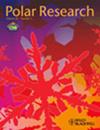2005年至2019年挪威斯瓦尔巴群岛鲸类动物的空间趋势
IF 1.3
4区 地球科学
Q3 ECOLOGY
引用次数: 5
摘要
这项研究使用通过公民科学计划获得的鲸目动物观测数据,更新2005-2019年期间斯瓦尔巴群岛周围水域鲸鱼和海豚的分布和空间趋势。基于内核密度估计,对早期(2005-2019)和近期(2015-19)的分布进行了比较,以确定该地区分布的潜在变化,该地区正经历快速变暖和随之而来的海冰损失。在三种北极特有鲸目动物中,白鲸(Delphinapterus leucas,也被称为白鲸)在整个研究过程中都有稳定的沿海分布,而独角鲸(Monodon monoceros)和弓头鲸(Balaena mystetus)仅在群岛以北观察到,但在最近一段时间内频率越来越高。白喙海豚(Lagenorhynchus albirostris)在斯瓦尔巴群岛西部和南部的大陆架断裂处有稳定的分布。抹香鲸的观测在早期从Bjørnøya西部转移到最近一段时间集中在斯匹次卑尔根西部的Prins Karls Forland北端附近。四种夏季居住的须鲸——蓝鲸(Balaenoptera musculus)、长须鲸(Balainoptera physalus)、座头鲸(Megaptera novaeangliae)和小须鲸(Baraenoptera acutorostrata)——在早期将其分布从斯匹次卑尔根以西的大陆架断裂转移到了近期的峡湾和沿海地区。这些变化与大西洋海水流入斯匹次卑尔根西海岸和群岛北部峡湾的增加相吻合。本文章由计算机程序翻译,如有差异,请以英文原文为准。
Cetacean spatial trends from 2005 to 2019 in Svalbard, Norway
This study uses cetacean sighting data, acquired via a citizen science programme, to update distributions and spatial trends of whales and dolphins in waters around the Svalbard Archipelago during the period 2005–2019. Distributions, based on kernel density estimates, from an early period (2005–2019) and a recent period (2015–19) were compared to identify potential shifts in distribution in this area, which is experiencing rapid warming and concomitant sea-ice losses. Among the three Arctic endemic cetaceans, white whales (Delphinapterus leucas, also known as beluga) had a stable, coastal distribution throughout the study, whereas narwhals (Monodon monoceros) and bowhead whales (Balaena mysticetus) were observed only north of the archipelago, but with increasing frequency during the recent period. White-beaked dolphins (Lagenorhynchus albirostris) had a stable distribution along the continental shelf break, west and south of Svalbard. Sperm whale observations shifted from west of Bjørnøya during the early period to being concentrated around the north end of Prins Karls Forland, west of Spitsbergen during the recent period. The four summer-resident baleen whales—blue whales (Balaenoptera musculus), fin whales (Balaenoptera physalus), humpback whales (Megaptera novaeangliae) and minke whales (Balaenoptera acutorostrata)—have shifted their distributions from the continental shelf break west of Spitsbergen during the early period into fjords and coastal areas during the recent period. These changes coincide with increased inflows of Atlantic Water into the fjords along the west coast of Spitsbergen and across the north of the archipelago.
求助全文
通过发布文献求助,成功后即可免费获取论文全文。
去求助
来源期刊

Polar Research
地学-地球科学综合
CiteScore
3.20
自引率
5.30%
发文量
22
审稿时长
>12 weeks
期刊介绍:
Since 1982, Polar Research has been the international, peer-reviewed journal of the Norwegian Polar Institute, Norway''s central institution for research, environmental monitoring and mapping of the polar regions. Aiming to promote the exchange of scientific knowledge about the Arctic and Antarctic across disciplinary boundaries, Polar Research serves an international community of researchers and managers. As an open-access journal, Polar Research makes its contents freely available to the general public.
Original primary research papers comprise the mainstay of Polar Research. Review articles, brief research notes, letters to the editor and book reviews are also included. Special issues are published from time to time.
The scope of Polar Research encompasses research in all scientific disciplines relevant to the polar regions. These include, but are not limited to, the subfields of biology, ecology, geology, oceanography, glaciology and atmospheric science. Submissions from the social sciences and those focusing on polar management and policy issues are welcome. Contributions about Antarctica are particularly encouraged.
 求助内容:
求助内容: 应助结果提醒方式:
应助结果提醒方式:


